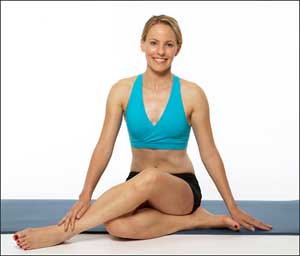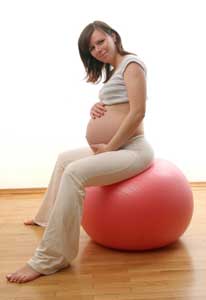The week of July 20 is Healthy Pregnancy Week at DietsInReview.com.
 Guest Blogger Alana Reed is the owner of Alana Reed Pilates. She was given the prestigious certification to teach Pilates in 2001 by Romana Kryzanowska, one of the five living disciples of Joseph Pilates. Alana works in New York City with clients of all ages and abilities. She specializes in pre- and post-natal Pilates and bone health. To learn more about Alana Reed, visit her website.
Guest Blogger Alana Reed is the owner of Alana Reed Pilates. She was given the prestigious certification to teach Pilates in 2001 by Romana Kryzanowska, one of the five living disciples of Joseph Pilates. Alana works in New York City with clients of all ages and abilities. She specializes in pre- and post-natal Pilates and bone health. To learn more about Alana Reed, visit her website.
Pilates is famous for being a great form of exercise during pregnancy. Not only does it keep you in shape during pregnancy, but it can also help keep traditional aches associated with pregnancy at bay. Also, it can help you get your pre-pregnancy figure back quickly after delivery!
When beginning a prenatal Pilates regimen, it is important that you first speak to your doctor about your workouts. After getting a doctor’s approval for Pilates, choose an instructor who has had prenatal training. Women all experience pregnancy differently. Some women feel fine throughout their first trimester and are able to continue the same pre-pregnancy workouts. Other women feel fatigued, have morning sickness, back discomfort or other symptoms. It is important that these symptoms be communicated to your instructor. There are over 400 different Pilates exercises. Your instructor should be able to tailor the workout to fit your needs.
 After the first trimester of pregnancy, the Pilates workout should change significantly. The basic changes should include:
After the first trimester of pregnancy, the Pilates workout should change significantly. The basic changes should include:
1. No flexion of the spine. This means no more hundreds, series of five or teasers with the head lifted off the mat. Basically all crunches should be eliminated from your workout after the first trimester.
2. Focus on strengthening the transverse abdominus and the oblique muscles. The changes in a woman’s body during pregnancy can cause a great deal of discomfort in the back. The deepest abdominal muscles, the transverse abdominals and the side abdominal muscles (obliques) if strong, can help support the back and significantly reduce back pain.
3. Do not spend more than a couple minutes on your back. In the second trimester, the doctor typically tells her pregnant patient to begin sleeping on her side. Laying flat on the back puts the full weight of the uterus on the spine and the inferior vena cava (the vein that transports blood from the lower body to the heart). Pregnant women often feel it’s difficult to take a deep breath when lying flat on the back. When exercising on the back, the pregnant woman should have pillows or something supporting her head, neck and shoulders to decrease the weight on her back.
4. Avoid inversions, or being upside down or lifting your legs over head.
5. When in doubt, leave it out! Pregnancy is not the time to muscle through a workout. If during the workout the woman feels pulling or discomfort around her belly or pelvis, that exercise should be stopped. The Pilates instructor should ask her client for feedback especially during any leg exercises.
You may be asking yourself what the cons are for doing Pilates while pregnant. As long as you have approval from your doctor to do Pilates exercises and your instructor has prenatal training, there are only amazing benefits!
Guest Blog Series: Look for the following badge on your favorite health sites to see if they have been a featured guest blogger on DietsInReview.com. See other posts in the Guest Blog series.
If you would like to apply to be featured as a guest blogger, please contact us.

